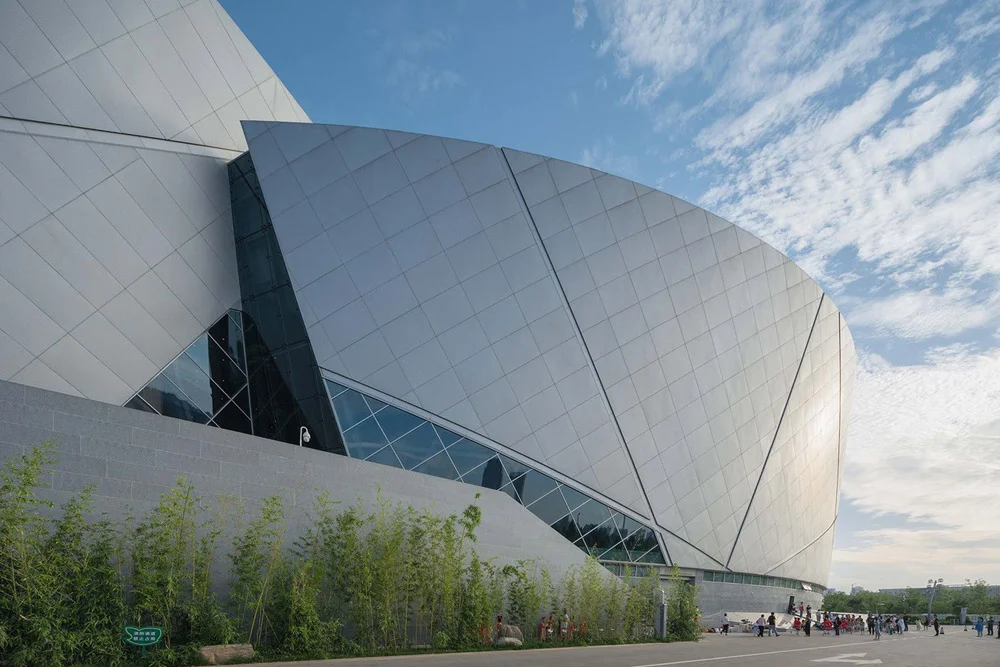By Alexia Hope
Copyright researchsnipers

Facade panels are critical these days to enhance physical appearance, heat conservation, and energy stability. Aluminum facade panels introduce lightweight robustness, improving thermal efficiency and offering buildings efficient protection against the elements.
Understanding Aluminum as a Sustainable Material
Aluminum is a lightweight and very recyclable metal. Its weight-to-strength ratio, corrosion resistance, and environmental friendliness make it a favorite of the modern structure, especially in practice as part of an aluminum facade framework.
Recyclability
Recycled aluminum never loses quality and can be recycled forever. Recycled aluminum saves energy during its production, cuts carbon emissions, and enhances sustainable building activities within the context of contemporary architecture.
Durability and Strength
Aluminum is resistant to corrosion, rust, and abrasive weathering. Its long life can help lower maintenance expenses while keeping its structural integrity intact so it is suitable for exterior purposes, most especially high-performance facade panels.
Energy Efficiency
The reflective properties of aluminum help manage heat absorption and lower the thermal gain. Together with insulation layers, aluminum facades can increase energy efficiency and help buildings earn green certifications.
Lightweight Advantages
Aluminum is easy to work with and lighter than most other common metals; hence, ease of assemble and building. Lightweight structures reduce the cost of construction, enhance design freedom, and promote sustainability with regard to materials used.
Use of aluminum to integrate into building exteriors, especially the use of aluminum facade panels, will help in providing a cleaner environment through efficiency and sustainability. Modern architecture relies heavily on its recyclability, strength, and energy efficiency.
How Aluminum Facade Panels Enhance Thermal Insulation
Aluminum facade panels enhance the insulation of buildings by reducing interior heat exchange. They are combined with modern insulation materials to reduce energy use such that occupants live comfortably with minimal impact on the environment.
Thermal Barrier Integration
Aluminum facade panels can be used with insulation layers to form excellent thermal barriers smoothly. The combination reduces heat loss in winter and also heat gain in summer, making the home more energy efficient overall.
Reduced HVAC Demand
Assisting in maintaining constant temperatures within a building, the aluminum panel also decreases the need to use heating, ventilation, and air conditioning units. Reduced HVAC use equates to lower energy bills and a smaller carbon footprint for buildings.
Reflective Surface Properties
The aluminum panels will reflect sunlight, and they will avoid overheating. This radiative property reduces the temperature in interior buildings during hot seasons, thus promoting thermal comfort and energy economy, furthermore to people.
Minimized Thermal Bridging
Well-designed aluminum facade panels avoid such thermal bridges, which frame areas through which heat easily flows. This gives consistent performance in insulation and enhances energy efficiency in the entire building over the years.
Aluminum panels with facade are critical in providing thermal insulation and low power consumption, and temperate room temperatures. Their integration with contemporary insulation means both heating and environmental soundness in the building.
The Impact on Energy Efficiency and Building Performance
Insulated aluminum facade panels provide a rate of heat transfer that makes a building extremely efficient in power conservation, maximization of natural light, and enhanced thermal control. Such advantages lead to low energy prices and a less heavy effect on the environment.
Optimized Energy Consumption
Aluminum facade panels limit the gain and loss of heat that may necessitate heating and cooling energy. This also means that buildings will be more efficient and generate sustainability in their operations all year round.
Enhanced Indoor Comfort
Indoors will have stable temperatures, which makes the environment comfortable to occupants. Constant climate enhances productivity, health, and overall satisfaction and lowers manufacturing dependence on mechanical climate systems.
Support for Green Certifications
Through energy-efficient aluminum facade plates, buildings have a greater chance of receiving certifications such as LEED or BREEAM, which would increase property value and show off a desire to remain sustainable and responsible in architecture.
Long-Term Performance
Aluminum panels retain their structural integrity and insulation factor over time, providing an equivalent standard of energy efficiency over time and thus lowering maintenance or replacement costs as opposed to other facade solutions available.
The use of aluminum facade panels in building construction comes with quantifiable cost savings on energy, enhanced comfort, and efficiency over the long term. Its performance is aimed at sustainable high-quality construction and support of environmentally friendly architecture.
Perforation Patterns: Balancing Light, Airflow, and Energy Savings
Wrapped up aluminum perforated panels are a beauty and a bountiful. The aluminum facade is perforated to provide natural lighting and ventilation, energy efficiency, and reduction of heat gain during the design of a sustainable building.
Daylighting Optimization
The pattern of perforations regulates the passage of sunlight, which limits the use of artificial lighting. There is a balance in the distribution of light: buildings save energy, make people feel comfortable, and have nice interiors.
Natural Ventilation
Strategic perforations enhance the flow of air, enhancing the quality of indoor air and making the use of mechanical ventilation systems unnecessary. This passive form of cooling can result in major savings of energy all year round.
Thermal Regulation
The perforated aluminum facade provides a shading screen on the facade to reduce direct solar heat gain. This cushions internal areas against overheating and lowers cooling energy demand to create a green building.
Architectural Flexibility
Top designers are able to design size, shape, and pattern of perforation. This can be combined with branding, designs or other art to provide visual appealing as well as practical insulation and energy considerations.
The integration of a perforated aluminum cladding works with lucrative building performance through balancing the daylight, ventilation, and thermal control. They are functional but very design-flexible panels that help facilitate energy saving and green building.
Comparing Aluminum Facade Panels to Other Metal Options
Aluminum facade panels are an exceptional combination of properties when compared it other metal facade. A properly designed metal facade will affect performance; however, aluminum offers higher sustainability and long-term value.
Weight and Structural Benefits
Aluminum panels are lightweight compared to steel or copper solutions. Lightweight structural loading eases assembly, reduces material and building cost, and reduces pressure on the supporting members, ideally benefiting aluminum in high-rise and big constructions.
Corrosion Resistance
Aluminum is lightweight, does not rust, and is not subject to the same paints and protective covering needed with some types of metals. This guarantees the facade a long aesthetic as well as a performance life span with minimum maintenance.
Thermal Performance
The reflectivity of aluminum enhances energy saving relative to darker or heavier metals. Combined with insulation, it improves the overall building thermal insulation; it can minimize the HVAC load and contribute to sustainable energy management that is sustainable.
Cost and Lifecycle Considerations
Aluminum panels can be a good compromise between initial cost and long-term benefits. The low maintenance costs, recyclability, as well as durability guide the price of aluminum facade to be cheaper than the alternative metals.
Compared to other metals, aluminum guarantees the best durability, energy, and sustainability as a metal facade. Its low maintenance nature as well as light weight strength are making it a choice solution in contemporary architecture.
Integration with Insulation Systems
Aluminum facade panels have synergy with contemporary insulation systems to maximize energy performance. The correct integration will provide uniform thermal performance, minimize thermal losses, and provide comfort temperatures indoors in various climates and building types.
Layered Insulation Design
A combination of aluminium panels with top-quality insulation cladding boosts thermal resistance. Such a multilayered design reduces energy transfer, benefiting sustainable building design and lowering the amount of heating and cooling in the long term.
Thermal Break Implementation
Thermal breaks between panels, to panel placement, or panel to structural connections will eliminate this heat bridge. This keeps insulation effectiveness consistent and allows facade panels in aluminum to work at their best in cool or scorching weather.
Moisture and Air Barrier Integration
Aluminum panels in combination with an appropriate vapor and air barrier protect insulation against moisture intrusion. This eliminates the growth of mold, supports energy efficiencies, and extends the life of the building.
Compatibility with Green Materials
Aluminum facades are able to incorporate environmental friendly insulation materials, which include mineral wool and recycled foam boards. The combination also increases the energy saving and is a contributor to sustainable construction certifications.
Facade panel unitized aluminum panels contribute, along with improved insulation systems, to optimizing thermal energy, preventing energy loss, and eliminating future maintenance. Well-designed and installed building envelopes are durable, comfortable, and perform soundly.
Acoustic and Environmental Benefits of Aluminum Facade Panels
Aluminum facade panels not only contribute to energy efficiency but also comfort with regard to acoustics or environmental performance. Their construction minimizes the external noise, serves sustainability, and makes indoor environments healthier and more comfortable to live in.
Noise Reduction
Aluminum coatings can be used together with insulation to absorb and prevent incoming sound. This minimizes the intrusion of urban noise, improves occupant comfort, and produces quieter domestic, commercial, and industrial spaces.
Recyclable Material
Aluminum can be easily recycled, without strength or quality loss. Aluminum facade panels encourage sustainability in construction, minimizing load in landfills, and upholding the principle of the circular economy in the construction industry.
Environmental Durability
Aluminum panels are resistant to corrosion, exposure to the sun, and all other weather-related conditions. They last long, so potential replacements and expansions have minimal impact on resources or the environment, in the long-term sense.
Energy Conservation Synergy
Aluminum facade elements minimize greenhouse emissions indirectly, through enhancing insulation and reflecting solar heat. This jointly promotes more energy-efficient buildings on top of reducing energy use and achieving the aspect of sustainable design.
Aluminum panels on the facade are cozy in their eco-friendly and acoustically sound. The use of recyclable materials, durability, and energy conservation are some of the features that make them an important choice in designing sustainable buildings with high performance.
Cost-Benefit Analysis of Aluminum Facade Panels
Investment in aluminum facade panels brings financial and environmental benefits in the long run. Though first costs are sometimes higher than the cost of alternatives, they outlast most short-life types of constructions and are energy-friendly, hence requiring lower maintenance costs.
Reduced Maintenance Costs
Aluminum panels are corrosion and wear-resistant, which minimizes repair and repainting requests. This saves the recurrent maintenance costs when compared to other facade materials, and this saves huge costs over the years of building usage.
Energy Savings
Reflective high insulation contributes to reduced heat and air conditioning costs. The energy saved because of using aluminum facade panels yields tangible economic savings and ensures sustainable construction as well.
Extended Lifespan
The aluminum facade panels have an extremely long lifespan and normally do not last decades. They last longer, and this saves costs spent on renovation or replacement and enhances the returns on investment during commercial and residential undertakings.
Incentives and Certifications
The difference in cost between aluminum and other materials can make a project eligible to achieve green building classification or a tax credit. Such programs may balance out the upfront cost, increase value to the property, as well as recognize the sustainable building methods.
An aluminum facade has a fascinating trade-off between initial costs and long-run financial/environmental returns. They will last long, will not consume much energy, and cost nothing to maintain, which makes them a nice, cost-effective choice in modern construction.
Conclusion – Aluminum Facade Panels as a Key to Sustainable Architecture
The use of aluminum facade panels is an energy efficiency achievement, having a thermal aspect of insulation, and versatile beauty in design in sustainable structures. They are durable, low-maintenance, and therefore built to promote green building materials.
Architects select the design of aluminum facade panels to ensure a better occupant experience, lower building energy costs, and smaller carbon emissions. These panels are just representative of how high-performance, sustainable building designs can be achieved using modern materials.



